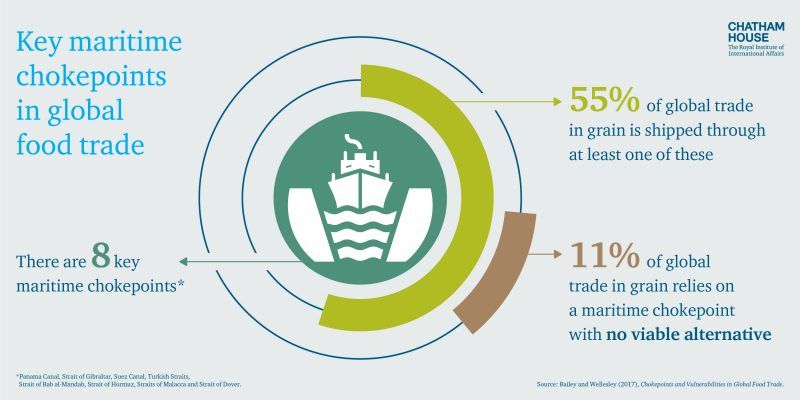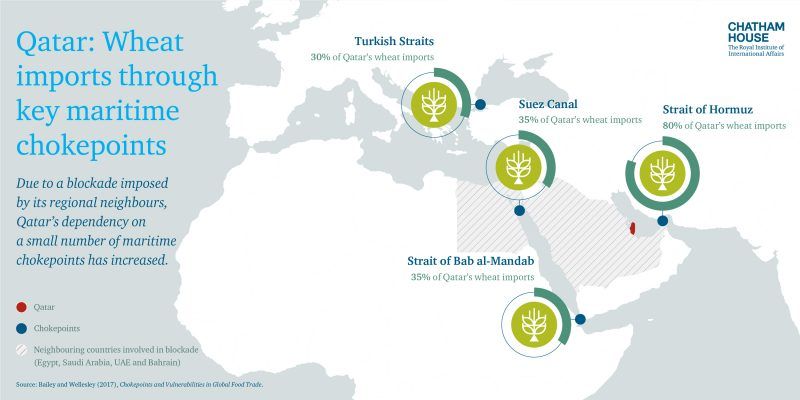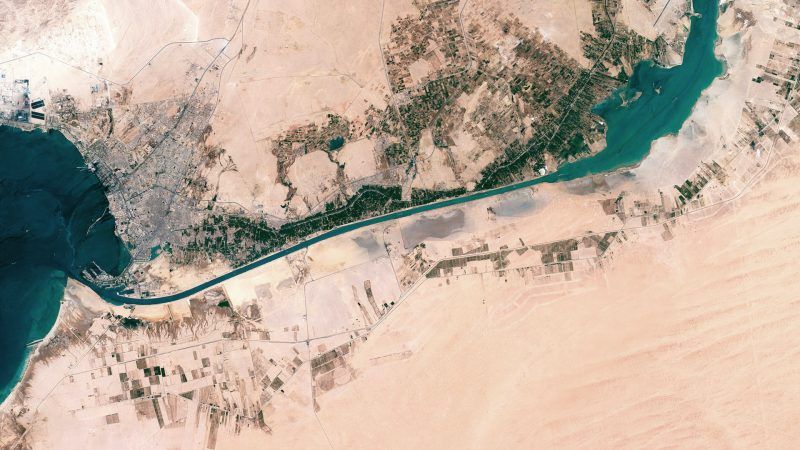
There are 14 major chokepoints that are critical to the international food trade. Report author Laura Wellesley and experts Conor Walsh and Andrew E. Tucci explain why policymakers must take action to mitigate the risk of severe disruptions at ports, maritime straits and inland transport routes, which could have devastating knock-on effects for global food security.
What are chokepoints and why are they important?
Conor Walsh: Chokepoints represent the inconvenient geographic realities that exist when distant producers and consumers seek to exchange goods and services.
Laura Wellesley: They are major infrastructure bottlenecks along international supply chains that could be maritime chokepoints like the Strait of Malacca or major canals like the Suez or Panama Canal. They could also be coastal hubs such as export centres for grain or they could be inland chokepoints like railway networks, roads or waterways that link ports to farms.
Conor Walsh: Chokepoints are important as they increase the vulnerability of supply chains to disruption, or rather, instances where a chokepoint has a high amount of trade means that disruptions are likely to be more severe, affecting a large proportion of trade and necessitating a more dramatic supply chain reorientation to reconnect the affected trade partners and ensure consumer demands are met
Laura Wellesley: Chokepoints are also important because they funnel a huge share of the global food supply in the most basic grains – grains that supply two-thirds of the world’s harvested calories. They’re really the gateway between the world’s breadbasket regions and the rest of the world that depends on food imports.
What do you see as the biggest threats facing food security and the global food trade over the coming years? How do chokepoints fit into this picture?
Conor Walsh: I perceive the biggest threats to food security as being those pressures that are likely to manifest in the short term. For example, some regions will exhibit increasing populations and at the same time reductions in crop yield due to climate related stresses which will make it more challenging for these regions to satisfy their domestic food demand. This will then necessitate an increase in imports especially if livelihoods are dependent on this.
Chokepoints, in this context, will be severely threatened by climate change: if climate change results in both increased import dependence for some producers in tandem with a greater reliance on other regions, reliance on a specific chokepoint may increase significantly. It is therefore important that keeping key chokepoints clear becomes even more important in a future of increasing demand and more pronounced climate change.
Laura Wellesley: I agree. The biggest challenge facing food security is climate change. Climate change threatens our food security in a number of ways. As we see climate change worsen we’ll see more frequent harvest failures around the world and those countries that already struggle to produce enough food and meet demand will probably suffer from the most severe impacts.
Food-insecure, low-income countries will be the hardest hit by droughts and floods and extreme weather that will destroy crops. That means that import dependence on our basic food supply is rising. That means that the importance of trade is rising. That means the importance of chokepoints is rising.
These chokepoints are vulnerable to climate change but also to day-to-day heavy rains or winds which affects the integrity of their infrastructure at key transport chokepoints, and as we see poor weather events become more frequent – and extreme – we are likely to see disruptions at these key bottlenecks.
Andrew E. Tucci: Food security faces many threats, including weakening governance structures, the potential for trade wars, climate change, growing populations and security concerns. These threats can manifest themselves at chokepoints which leverage their impact and magnify their consequences up and down the supply chain. It is important to note that chokepoints can also have a positive impact on food security, if nations can use chokepoints as actual points to focus their efforts in promoting sound governance.

Which countries do you think are most at risk and why? Does this vary between low-income and high-income countries?
Conor Walsh: Climate change is a global process which means it will manifest everywhere but what this means will be different depending on the regional context. I think regions which are likely to exhibit both population increases and more severe climate change impacts are at the greatest risk, such as in northern and sub-Saharan Africa and in the Middle East. Examining the trends in population, consumption and potential climate change impacts suggests that countries such as Egypt and Nigeria, for example, could actually become almost wholly import-dependent by 2050.
In contrast, regions such as Russia and Canada may potentially benefit from increases in cultivable land. In 2016, we saw how increased production in regions such as Russia allowed for Russian wheat to levy a competitive advantage and erode the market penetration of US wheat in African markets such as Nigeria. However the costs and damaging impact on its domestic sector resulted in Nigeria capping wheat imports at a certain level. Nonetheless, Russian wheat exports continue to expand, with significant movement through the Bosphorus straits. But the net gain under climate change is highly uncertain.
Laura Wellesley: Yes, the level of risk varies between high- and low- income countries. There are import-dependent, high-income countries such as South Korea and Japan, who really need to consider the dependency of their food imports on a small number of chokepoints. But being high-income countries, they have the capacity to cope with a potential supply shortage: they have the financial capacity to source imports from elsewhere and they’re able to support their populations at risk.
In the case of low-income, food deficit countries, that’s not the same. The vulnerabilities are much higher because at both the national and household level the spending on food from total available financial resources is extremely high and the options for accessing higher priced food – when we see a food shortage, we tend to see food prices rise – is limited. There is an existing level of high food insecurity that could be easily worsened or tip a food insecure population into crisis.
Does the changing climate and political or social instability affect the threat of disruptions to chokepoints? How?
Conor Walsh: Certainly. Ports or centres of production play a vital role in most modern economies and therefore serve a strategically important function during periods of unrest. We have seen how political tensions in Libya, intensified by water stress, resulted in oil terminal ports being seized by rebels in 2011 and 2016 and exports being disrupted. Similarly the increasing cost of grain prices as a result of the Russian export embargo in Egypt prompted protests, as the subsidizing of wheat was unable to compete with the resultant price increase due to supply chain difficulties.
The stresses associated with the availability of basic commodities such as wheat and water can exacerbate the socioeconomic conditions which imperil supply chain functioning such as piracy.
Laura Wellesley: For me, climate change will particularly threaten chokepoints. The risk of climate-related disruptions to chokepoints will rise as climate change worsens but climate change is also expected to have a risk multiplying effect on political and security hazards. We’re looking likely to see more conflicts over land and water and scarce resources, but also a greater risk of countries imposing protectionist measures when their own food supplies are threatened.
At a global level, protectionism will put pressure on prices and limit supply if lots of countries follow the same path. We saw that in the 2010 food crisis where there was a really rapid contagion of export controls that was really the issue rather than a supply shortage.
Andrew E. Tucci: Sea level rise and severe weather events will have a significant impact on ports and waterways, for example, rising sea level can flood port terminals and make passage of large vessels under bridges impossible. Social and political instability therefore weakens the governance structures and institutions that must plan, fund and execute the infrastructure and other measures that can reduce the impact of these changes.

Are there particular recommendations in the report that you think should be the priority for national governments, the international community or industries?
Conor Walsh: I would argue that the recommendation to invest in infrastructure to ensure future food security is a critical policy priority especially in a changing climate. Conventionally, trends of increasing import dependency might not be seen as terminally dangerous in the face of historic growth in yields and crop production; however, under a future in which climate change impacts are manifested and yields cannot keep pace with consumptive demand, additional infrastructure will be necessary to minimize the impact of supply chain disruptions.
Laura Wellesley: I think in the first instance there’s a really urgent need for governments and the international community to better assess and understand the risks. Until now the importance of chokepoints and the physical infrastructure to global food security has been largely overlooked and until we understand the risks, it will be difficult to manage these risks. So I think the immediate priority is to establish mechanisms, working groups, task forces at the national and international level to figure out just how dependent we are on chokepoints. How much of a risk do they pose and where do the major vulnerabilities of different populations lie?
Beyond that, the other priority is investment: ramping up investment in infrastructure that is fit for the future so it can withstand climate change and cope with the rising volume of trade. This report looks particularly at North America, South America and the Black Sea, and each of these regions has proved unfit so far.
Andrew E. Tucci: For me, national and international governance is key. The global supply chain is remarkably resilient, but that resilience has its limits. Chokepoints are testing that resilience on a routine basis and can contribute to acute shortages in food supply when all is not well with the world. Those shortages can lead to human suffering and instability. Sound governance can minimize the likelihood of trouble at a chokepoint occurring and will help facilitate a quick, orderly response when chokepoint-related disruptions do occur.
In your field, how have chokepoints been considered until now? How have the risks of chokepoint disruption been managed and does this now need to change?
Conor Walsh: Within climate change research, chokepoints have rarely been analysed as an issue itself, other than as an indicator of unsustainable consumption. I believe it behoves us to examine the implications of significant and regular disruptions to supply across several vital trade routes for essential commodities, and not merely look at these individually. The role of chokepoints serves as a timely and fiercely relevant consideration when discussing climate change. Additionally I believe there needs to be additional global efforts to circumvent market failures that might become commonplace when climate change impacts become more severe. What happens when transit through very difficult but increasingly vital chokepoints becomes inviable? This is a matter of humanitarian urgency and failure to prepare for worst case scenarios risks regional stability.
Laura Wellesley: In the sphere of food security, the chokepoint risks that we’re looking at in our report really haven’t featured in research or government strategies up until this point.
In the context of developing countries, the need for infrastructure investment and greater market connectivity, both within national borders and across international markets, has long been recognized and has been a priority for multilateral banks and donor agencies and civil society – but there has been very little attention paid to the importance of infrastructure in middle and advanced economies that are the breadbasket regions of the world.
Andrew E. Tucci: In slight contrast, in my coast guard work, there have been many activities related to strengthening our chokepoint resilience, including protection of critical infrastructure, building governance at the multilateral, bilateral and local level, and in contingency planning and emergency operations related to restoring maritime commerce after a disruption to a chokepoint, and we are continuing to work on this area.

How do you see the insights in this report being used by those in your field? What opportunities do you see for learning across sectors, disciplines and geographies to boost the resilience of the global food trade?
Conor Walsh: This report gives practical examples of the broad and potentially unexpected ways in which climate change vulnerability will be manifested. Dependable supply of materials in the future cannot be relied upon, and I believe the points raised in this report advocate for viewing climate change adaptation in a wider context to include the full gamut of measures which will reduce the risk of our over-reliance on chokepoints – including seeking to keep passages free and supply sustained.
I see the main opportunity for learning – with regards to resilience – is a greater awareness across sectors of the indirect implications of climate mitigation. For example it may not be apparent to horticulturists or agricultural scientists that seeking domestically grown, more climate tolerant alternatives to cereals, for example, may have a tacit benefit in alleviating reliance on the transit of imports through a chokepoint for grain trade.
Laura Wellesley: I hope that the insights of our report will be taken forwards by a range of actors in the field of food security in assessing national dependence on food imports and infrastructural chokepoints, and also on the strategic global importance of bottlenecks among governments in breadbasket regions in advanced economies.
Equally important is for the research community to build on this initial assessment and draw on a range of expertise from network analysts to transportation networks, to insurers and investors to figure out the next steps in building resilience and managing the risk of chokepoint disruptions. The international community has a major role to play both in encouraging investment in resilient infrastructure and in better governing the political and security risks that threaten chokepoint operations. So, for example, designating critical food security corridors where they exist and setting up shipping lanes that really need to be kept open to avoid a major food emergency as well as the supervision of those corridors by the UN World Food Programme, could then form the basis of more normative agreements between states to work together in the case of a disruption and protect the passage of critical food supplies.
In terms of learning across sectors, we argue that the energy sector has long recognized the market risks posed by maritime chokepoints like the Strait of Hormuz – and one of the ways that major oil exporting and importing countries have sought to manage the risks of chokepoint disruption has been through the International Energy Agency’s emergency sharing mechanism, by which countries are required to maintain a certain level of oil reserves that are then released in an agreed way in the case of a supply shortage. Whether that will work for food is a difficult question, and there have been major concerns in oil sector over whether countries will share their resources if their own supply was threatened. So any kind of agency that seeks to set normative and non-binding rules to administer chokepoint risks will need to take into account the potential for protectionist trade measures by countries.
Andrew E. Tucci: Chokepoints are not simply vulnerabilities to the abstract concept known as food security – they are vulnerabilities to human beings around the world too. This report highlights that we have a moral obligation to work towards common solutions. The good news is that as we work towards improvements in food security we can use the focus on chokepoints to draw in other stakeholders and leverage our efforts in other areas of local, regional and global cooperation.
Laura Wellesley, Research Associate, Energy, Environment and Resources. Dr Conor Walsh, Environmental Scientist, Natural Resources Institute, Department of Agriculture Health and Environment, University of Greenwich and Captain Andrew E. Tucci, Sector Commander, US Coast Guard.
